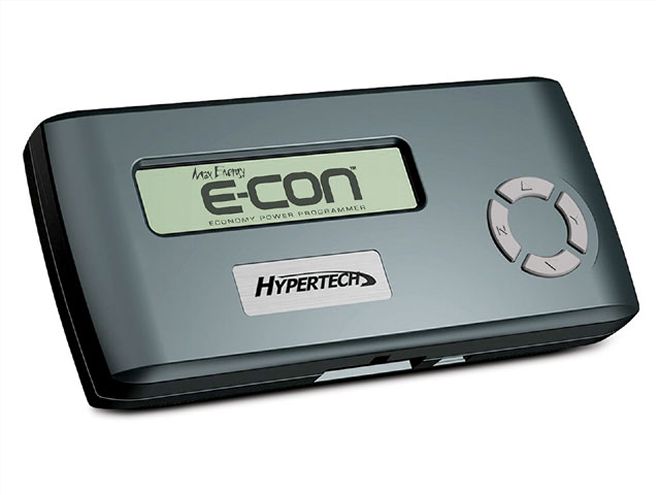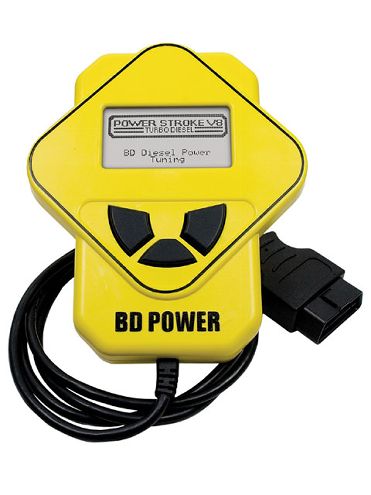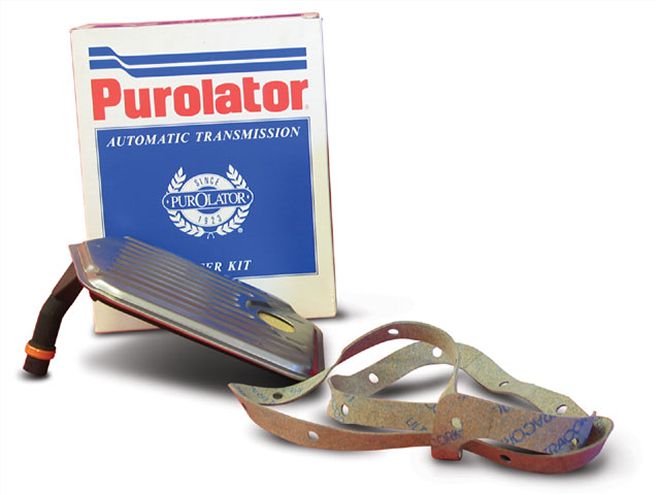
| Filling up at the pump is becoming a nightmare once again. However, you don't have to give up performance to gain fuel economy. In fact, when done correctly, you can add performance and improve mpg at the same time.
There are some inevitable truths in life. Death, taxes, and the fact that your fullsize pickup will never be able to rival a Prius for mileage. But if you feel you are doomed to 8 to 12 mpg for the rest of your vehicle's life, there is hope yet. We've come up with some basic steps that any truck owner can follow to eke out a few extra miles per gallon.

| increase Mpg high Performance Motor Oil
1. Oil Viscosity and SyntheticsChances are if you're a sport truck enthusiast, you probably lavish more attention on your ride than most vehicle owners. Proper maintenance is key to achieving overall vehicle efficiency. Along with regular oil changes (every 3,000 to 5,000 miles), switching to a lower-viscosity oil during the winter months (and year-round) can increase efficiency and reduce the pumping losses in the engine. Switching from a thick 20W50 to thinner 5W30 will make a noticeable difference in responsiveness. Unless you do frequent towing or hauling, the thicker-viscosity oils are not necessary. For most light truck use, 10W30 should be a good compromise, but consult your owner's manual for factory recommendations.
In extremely cold climates, it makes sense to go to a 0W30 or 0W40 oil to expedite oil flow in subfreezing conditions. Synthetics tend to have superior lubrication and temperature breakdown resistance to conventional petroleum-based oils. The only major downside is the significantly steeper cost, generally twice as much as equivalent-viscosity conventional oil.
2. Transmission and Differential EfficiencyThough proper engine maintenance is fairly common knowledge, often-overlooked areas that can significantly contribute to the efficiency of your vehicle are the transmission and differential. With older vehicles, it's a good idea to change the transmission fluid or gear oil on manual transmissions at 30,000-mile intervals, or more frequently under demanding conditions. It's also advisable to change the rear differential oil at the same interval. With many newer vehicles, the transmissions have lifetime service intervals on the transmission (generally 100,000 miles).
-

-
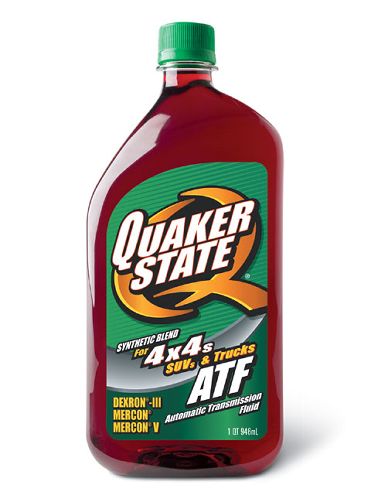
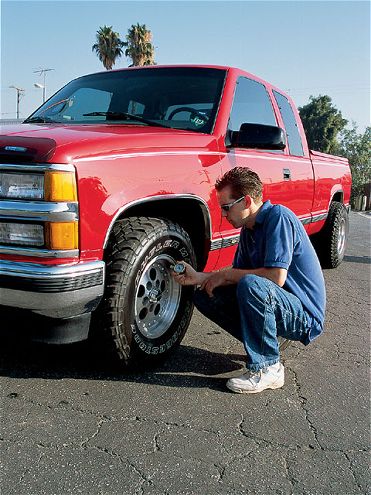
| Fuel-Saving TipKeeping your tire pressures at factory-recommended levels limits the amount of overall drag your truck produces. Properly inflated tires decrease the rolling resistance of the truck and improve fuel economy.
While the quality of the lubricants and the tolerances of the mechanical systems from the factory have improved dramatically in the last few years, it probably wouldn't hurt to change these fluids every 50,000 miles.
3. Proper Tire PressureTire inflation can have a significant effect on vehicle efficiency. Underinflated tires may give a smoother ride, but they also increase rolling resistance. Tires should be inflated to the manufacturer's specifications, and on the high side of those recommendations for maximum efficiency. It's best to consult your owner's manual and the literature that came with your tires. Inflating tires to the maximum psi listed on the sidewall can be dangerous and may increase tire wear.
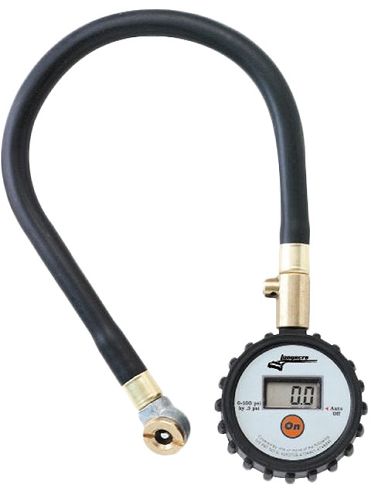
| increase Mpg tire Gauge
For accurate tire pressure readings, check the tires when cold, as driving heats the air inside the tires and effectively increases the inflation reading. Check tire pressure before going on a long trip, and always check it before towing or hauling heavy loads. In extremely hot conditions, check the pressure periodically to make sure the tires are not reaching the maximum safe inflation level.
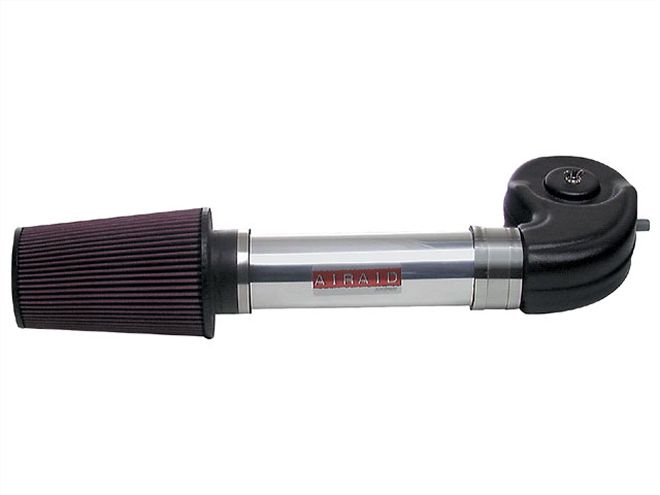
| Fuel-Saving TipImproving on the engine's ability to breathe helps improve fuel economy by making the engine run more efficiently. This Airaid air intake system improves airflow into the engine by removing some of the restrictions intended to decrease noise.
4. Performance Intake SystemsIf the performance gains from intakes are so easy, you ask, why don't they come equipped with them from the factory? Consider the overriding development mantra of "NVH" that manufacturers are working under today. Noise, vibration, and harshness are the supreme evils singled out by most new-vehicle engineers. Performance is often sacrificed in pursuit of providing the quietest, smoothest vehicle to the customer.
Although most of you reading this probably enjoy the healthy honk of an open intake under the whip, the manufacturers have surmised that 90 percent of the public finds this noise offensive, so they strangle the intake tract in the name of smothering NVH. Since the engine has to overcome these restrictions when inhaling, it often reduces the overall efficiency of the motor.
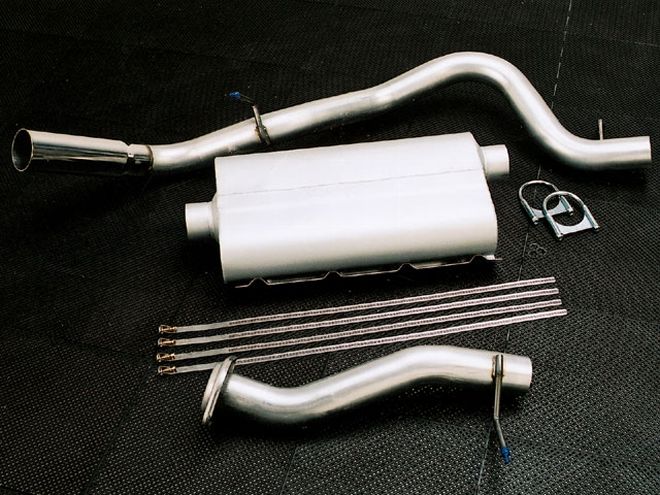
| It's widely known that reducing backpressure increases horsepower and torque, but not at the expense of fuel economy. This Flowmaster system for a late-model Tahoe/Yukon is one example of a way to increase performance without sacrificing mileage.
5. Performance ExhaustsThe reason vehicles aren't equipped with performance exhausts from the factory follows the same rationale as with intakes. The mass market wants their transportation quiet and smooth, but most red-blooded enthusiasts would rather hear the melodious baritone of a well-tuned V-8 burbling through a free-flowing exhaust system.
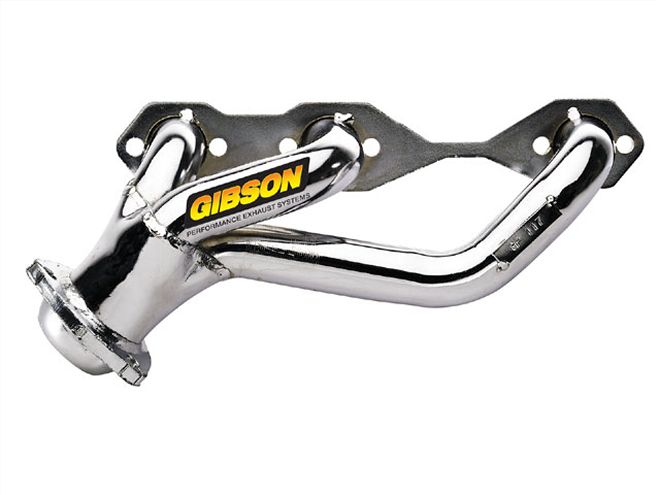
| Fuel-Saving TipHeaders are another way to help tune your engine to promote good exhaust flow, thus improving fuel economy. These Gibson headers for a Chevy V-6 promote increased torque, raising the level of available power while using the same amount of fuel.
There are many different systems on the market employing different construction techniques and engineering philosophies. Most factory mufflers are of the "chamber" type, routing the exhaust through multiple chambers before sending it out the tailpipe. A freer-flowing variation on this design has been perfected by several aftermarket manufacturers and provides a throaty sound that has made it a favorite among many enthusiasts.
Many performance mufflers also employ a straight-through design. Basically, the muffler is a straight section of perforated pipe surrounded by sound-attenuation packing. This design is well-suited for vehicles equipped with a supercharger or turbo because it reduces backpressure and lowers exhaust temperatures. Most of the better systems on the market have been dyno-tested to offer a performance increase in the most commonly used rpm ranges.
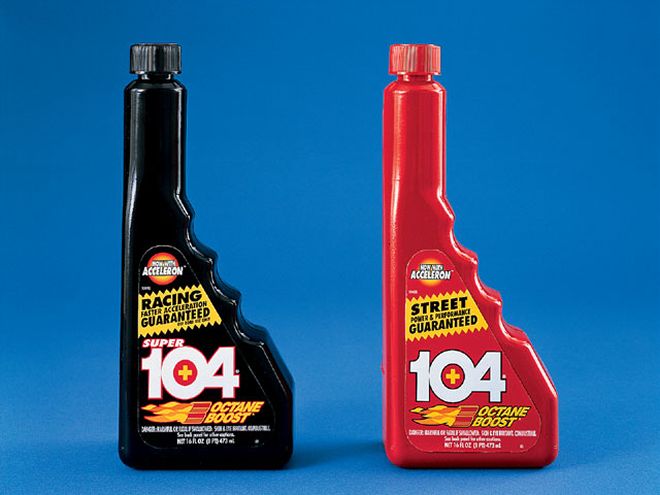
| Octane boost is great for raising octane levels one to two points. It is, however, only a temporary fix.
6. Premium FuelIt is common knowledge that higher-octane gasoline increases fuel efficiency. However, from a dollar standpoint, the numbers may not justify filling up with "high-test." Premium fuel can be more than 20 cents a gallon more than 87 octane. On a 30-gallon tank, that's $6. If you fill up weekly, that's $24 a month. Probably not the difference between making the rent or sleeping in your truck bed, but it's enough for two large pizzas. Unless your owner's manual specifies premium fuel, or your vehicle is equipped with a turbocharger or supercharger, you don't really need premium fuel.
7. Lubricant EnhancersThis crowded segment is rife with competing claims and different manufacturers doing various "bearing" tests and pouring sand down the oil filler cap. Some of the more cynical sages in the industry have called these modern-day snake oils. Though it's unlikely you'll see an additional 3 to 5 mpg from merely pouring in a bottle of lubricant enhancer, none of them is likely to harm your engine. At $20 to $30 a bottle, you can afford to experiment with different products for best results. However, do not mix lubricant enhancers. Wait until the next oil change to pour in a new enhancer. Be careful not to exceed your engine's crankcase oil capacity when adding an enhancer. An overfilled crankcase can lead to foaming and inadequate oil pickup, which will cause far more damage than any good you might get from an enhancer.
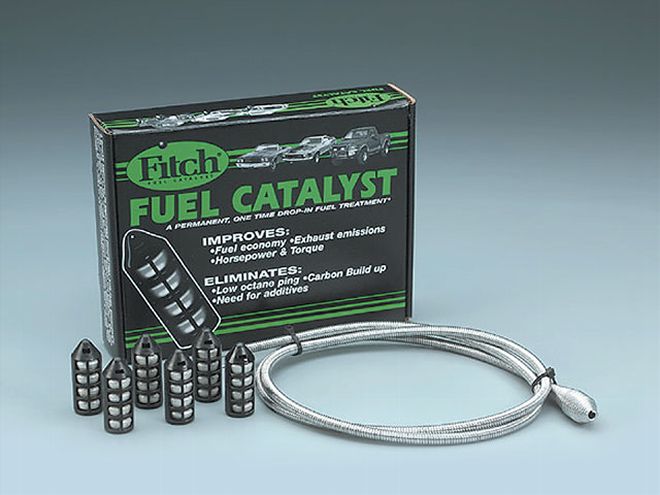
| increase Mpg fitch Fuel Catalyst
Sport Truck Product Spotlight
Fitch Fuel CatalystWith fuel costs rising rapidly, many sport truck enthusiasts are scrambling to find ways to improve upon their truck's fuel economy. Those of us blessed with SUVs (especially supercharged ones) tend to be the most desperate. Large engines with large fuel tanks often take $80 or more of high-octane fuel. In our search for ways to improve fuel economy, we came across the Fitch Fuel Catalyst, manufactured by Advanced Power Systems International, founded by John Fitch, veteran race car champion. The fuel catalyst claims to reduce emissions and improve fuel economy by treating the fuel in the tank. The fuel treatment keeps the gasoline fresh for improved combustion. In turn, the engine runs more efficiently, thus increasing fuel economy. The representatives at APS did not divulge what the components are that make up their catalyst and recommended that we try a set on our '95 Chevy Suburban.
At first, we were resistant to dropping some "magic pellets" into our truck's fuel tank, but we figured we had nothing to lose. Following the directions, we installed several of the catalyst pellets in our fuel tank. The number of pellets will depend on the size of the tank. APS also recommends resetting the factory computer by disconnecting the negative battery terminal and reconnecting it after a few minutes. We were also skeptical to the claims that we would improve our fuel economy by as little as 1.5 to 2 mpg, but, to our surprise, we ended up getting a 2.5-mpg improvement.
Our test began with measuring the combined highway and city average fuel consumption. Over one month, we averaged 13.3 mpg. After installing the Fitch Fuel Catalyst, we drove the vehicle for another four-week period and took an average. The result was a 15.8-mpg average. Considering that our test vehicle has over 85,000 miles on a 7.4L TBI engine, the results were well worth the $119 price tag.
According to APS, the catalyst will last the life of the vehicle and not clog any fuel pumps or any part of the fuel system. The Fitch Catalyst is also available in an inline system for vehicles that won't allow the use of pellets in the tank.
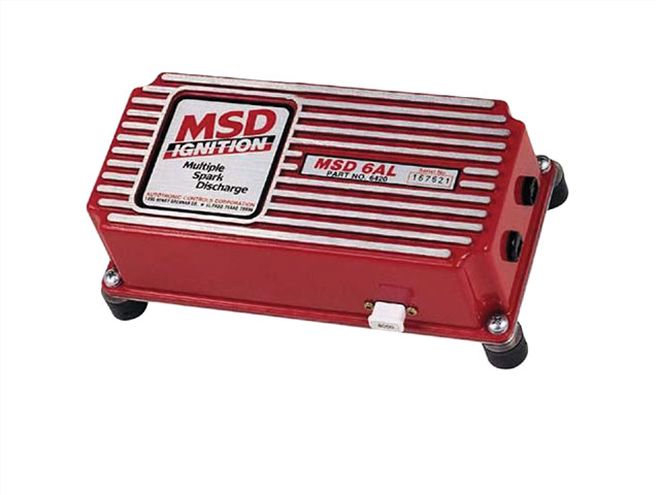
| Fuel-Saving TipImproving upon your engine's spark can help increase its fuel economy. Tests have shown that some multispark and high-capacitive ignition systems improve fuel economy by 0.8 mpg.
8. Driving StyleEven if you take all of these measures to improve your vehicle's economy, nothing will suck up more gas than a lead foot. Sure, we all like to indulge the urge for surge every now and then, but even a miserly Honda Civic can dip below 20 mpg under an unrelenting heavy foot. On level roads, there should be little need to rev the engine much above 2,000 rpm during normal driving, especially with generally torquey truck engines.
On the freeway, engage Overdrive on automatics, unless towing or hauling, and upshift into the Overdrive gear on manuals. Cruise control is an effective economy tool on level roads, but can actually increase fuel consumption on uphill climbs. Above all, use common sense, and it may pay off by saving you dollars.
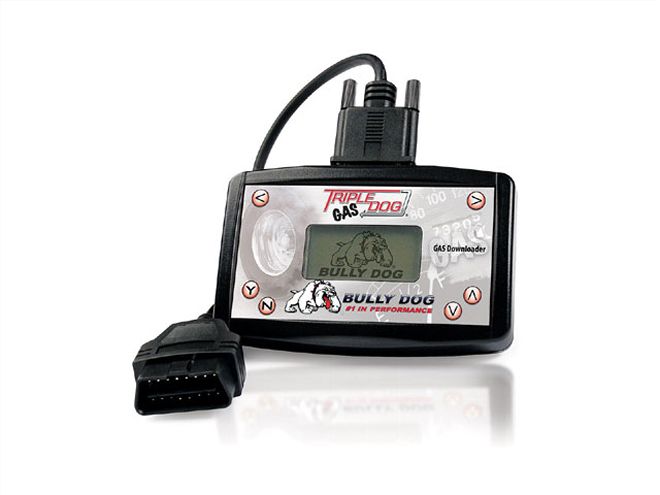
| Fuel-Saving TipTonneau covers not only secure items in your bed, they also improve airflow over it.
9. Tonneau Covers and Camper Shells Pickups have inherently poor aerodynamic characteristics. This is partly due to their open beds and tailgate, which cause a great deal of turbulence and, consequently, aerodynamic drag. However, contrary to popular belief, recent studies have shown that simply lowering your tailgate increases drag.
Unless you're hauling on a daily basis, a tonneau cover might be a wise investment. Not only does it clean up your truck's styling, but it also eliminates a great deal of the aerodynamic drag associated with a pickup. If you do haul frequently but still want the increased efficiency afforded by a tonneau, several companies offer retractable bedcovers.
Camper shells no longer have the "Grandpa's fishing rig" stigma they used to. Early shells looked like they were constructed from scraps from the Winnebago factory, using stylish ribbed, wood-textured fiberglass slabs. Newer models are contoured, have flush-mounted glass, are available in the most popular colors, or can be painted to match your vehicle. In addition to giving you a large, secure cargo area, the better-designed models also reduce drag.
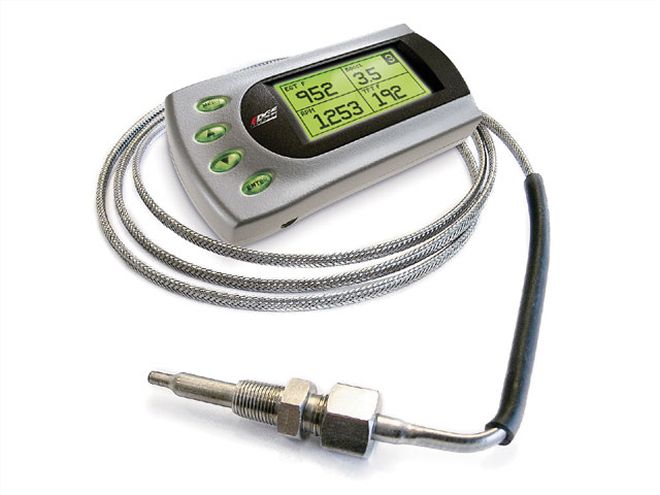
| increase Mpg engine Programmer
10. Engine ProgrammersMost later-model domestic fullsize trucks have many aftermarket options available to improve performance and efficiency. These plug-in programmers allow the owner to adjust spark timing, injector pulse width, speedometer calibration, and a variety of other variables to improve overall efficiency. Note that certain settings require use of premium fuel.
The Final WordIf you follow these 10 simple steps, your truck will be more efficient and sip the gas instead of chugging it. Out of all the things we talked about, the electronic power programmers constitute the easiest semipermanent power-and-mileage modification you can perform. Just about every one on the market boasts mileage increases, but there are so many available it's difficult to determine what your options are. Have no fear! Following this story is a guide to programmers that will tell you what they do and where to get them. All you need to do is decide which one is best for your specific application.
 | Filling up at the pump is becoming a nightmare once again. However, you don't have to give up performance to gain fuel economy. In fact, when done correctly, you can add performance and improve mpg at the same time.
There are some inevitable truths in life. Death, taxes, and the fact that your fullsize pickup will never be able to rival a Prius for mileage. But if you feel you are doomed to 8 to 12 mpg for the rest of your vehicle's life, there is hope yet. We've come up with some basic steps that any truck owner can follow to eke out a few extra miles per gallon.
| Filling up at the pump is becoming a nightmare once again. However, you don't have to give up performance to gain fuel economy. In fact, when done correctly, you can add performance and improve mpg at the same time.
There are some inevitable truths in life. Death, taxes, and the fact that your fullsize pickup will never be able to rival a Prius for mileage. But if you feel you are doomed to 8 to 12 mpg for the rest of your vehicle's life, there is hope yet. We've come up with some basic steps that any truck owner can follow to eke out a few extra miles per gallon.
 | increase Mpg high Performance Motor Oil
1. Oil Viscosity and Synthetics
| increase Mpg high Performance Motor Oil
1. Oil Viscosity and Synthetics

 | Fuel-Saving TipKeeping your tire pressures at factory-recommended levels limits the amount of overall drag your truck produces. Properly inflated tires decrease the rolling resistance of the truck and improve fuel economy.
While the quality of the lubricants and the tolerances of the mechanical systems from the factory have improved dramatically in the last few years, it probably wouldn't hurt to change these fluids every 50,000 miles.
3. Proper Tire Pressure
| Fuel-Saving TipKeeping your tire pressures at factory-recommended levels limits the amount of overall drag your truck produces. Properly inflated tires decrease the rolling resistance of the truck and improve fuel economy.
While the quality of the lubricants and the tolerances of the mechanical systems from the factory have improved dramatically in the last few years, it probably wouldn't hurt to change these fluids every 50,000 miles.
3. Proper Tire Pressure | increase Mpg tire Gauge
For accurate tire pressure readings, check the tires when cold, as driving heats the air inside the tires and effectively increases the inflation reading. Check tire pressure before going on a long trip, and always check it before towing or hauling heavy loads. In extremely hot conditions, check the pressure periodically to make sure the tires are not reaching the maximum safe inflation level.
| increase Mpg tire Gauge
For accurate tire pressure readings, check the tires when cold, as driving heats the air inside the tires and effectively increases the inflation reading. Check tire pressure before going on a long trip, and always check it before towing or hauling heavy loads. In extremely hot conditions, check the pressure periodically to make sure the tires are not reaching the maximum safe inflation level.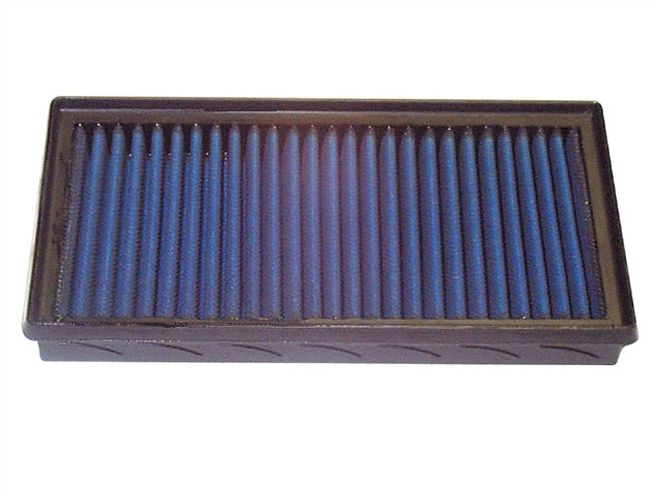
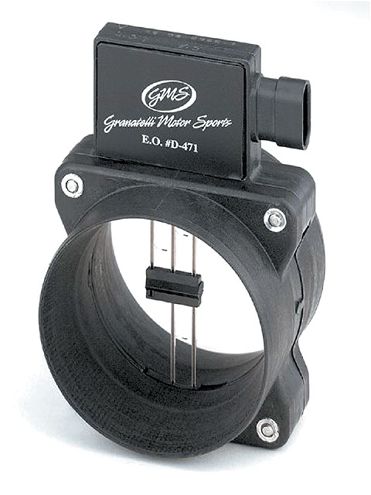
 | Fuel-Saving TipImproving on the engine's ability to breathe helps improve fuel economy by making the engine run more efficiently. This Airaid air intake system improves airflow into the engine by removing some of the restrictions intended to decrease noise.
4. Performance Intake Systems
| Fuel-Saving TipImproving on the engine's ability to breathe helps improve fuel economy by making the engine run more efficiently. This Airaid air intake system improves airflow into the engine by removing some of the restrictions intended to decrease noise.
4. Performance Intake Systems | It's widely known that reducing backpressure increases horsepower and torque, but not at the expense of fuel economy. This Flowmaster system for a late-model Tahoe/Yukon is one example of a way to increase performance without sacrificing mileage.
5. Performance Exhausts
| It's widely known that reducing backpressure increases horsepower and torque, but not at the expense of fuel economy. This Flowmaster system for a late-model Tahoe/Yukon is one example of a way to increase performance without sacrificing mileage.
5. Performance Exhausts | Fuel-Saving TipHeaders are another way to help tune your engine to promote good exhaust flow, thus improving fuel economy. These Gibson headers for a Chevy V-6 promote increased torque, raising the level of available power while using the same amount of fuel.
There are many different systems on the market employing different construction techniques and engineering philosophies. Most factory mufflers are of the "chamber" type, routing the exhaust through multiple chambers before sending it out the tailpipe. A freer-flowing variation on this design has been perfected by several aftermarket manufacturers and provides a throaty sound that has made it a favorite among many enthusiasts.
Many performance mufflers also employ a straight-through design. Basically, the muffler is a straight section of perforated pipe surrounded by sound-attenuation packing. This design is well-suited for vehicles equipped with a supercharger or turbo because it reduces backpressure and lowers exhaust temperatures. Most of the better systems on the market have been dyno-tested to offer a performance increase in the most commonly used rpm ranges.
| Fuel-Saving TipHeaders are another way to help tune your engine to promote good exhaust flow, thus improving fuel economy. These Gibson headers for a Chevy V-6 promote increased torque, raising the level of available power while using the same amount of fuel.
There are many different systems on the market employing different construction techniques and engineering philosophies. Most factory mufflers are of the "chamber" type, routing the exhaust through multiple chambers before sending it out the tailpipe. A freer-flowing variation on this design has been perfected by several aftermarket manufacturers and provides a throaty sound that has made it a favorite among many enthusiasts.
Many performance mufflers also employ a straight-through design. Basically, the muffler is a straight section of perforated pipe surrounded by sound-attenuation packing. This design is well-suited for vehicles equipped with a supercharger or turbo because it reduces backpressure and lowers exhaust temperatures. Most of the better systems on the market have been dyno-tested to offer a performance increase in the most commonly used rpm ranges.
 | Octane boost is great for raising octane levels one to two points. It is, however, only a temporary fix.
6. Premium Fuel
| Octane boost is great for raising octane levels one to two points. It is, however, only a temporary fix.
6. Premium Fuel | increase Mpg fitch Fuel Catalyst
Sport Truck Product Spotlight
| increase Mpg fitch Fuel Catalyst
Sport Truck Product Spotlight | Fuel-Saving TipImproving upon your engine's spark can help increase its fuel economy. Tests have shown that some multispark and high-capacitive ignition systems improve fuel economy by 0.8 mpg.
8. Driving Style
| Fuel-Saving TipImproving upon your engine's spark can help increase its fuel economy. Tests have shown that some multispark and high-capacitive ignition systems improve fuel economy by 0.8 mpg.
8. Driving Style | Fuel-Saving TipTonneau covers not only secure items in your bed, they also improve airflow over it.
9. Tonneau Covers and Camper Shells
| Fuel-Saving TipTonneau covers not only secure items in your bed, they also improve airflow over it.
9. Tonneau Covers and Camper Shells | increase Mpg engine Programmer
10. Engine Programmers
| increase Mpg engine Programmer
10. Engine Programmers